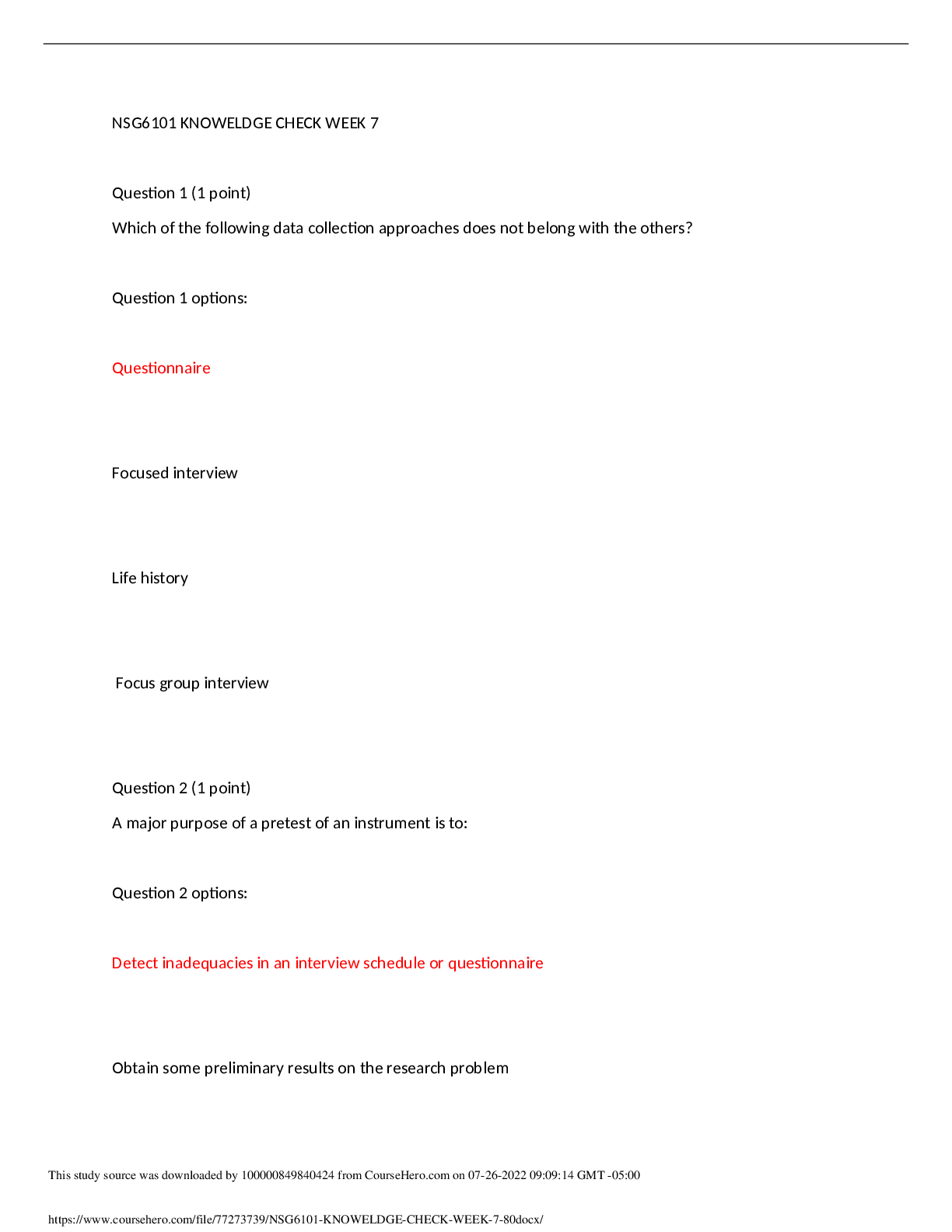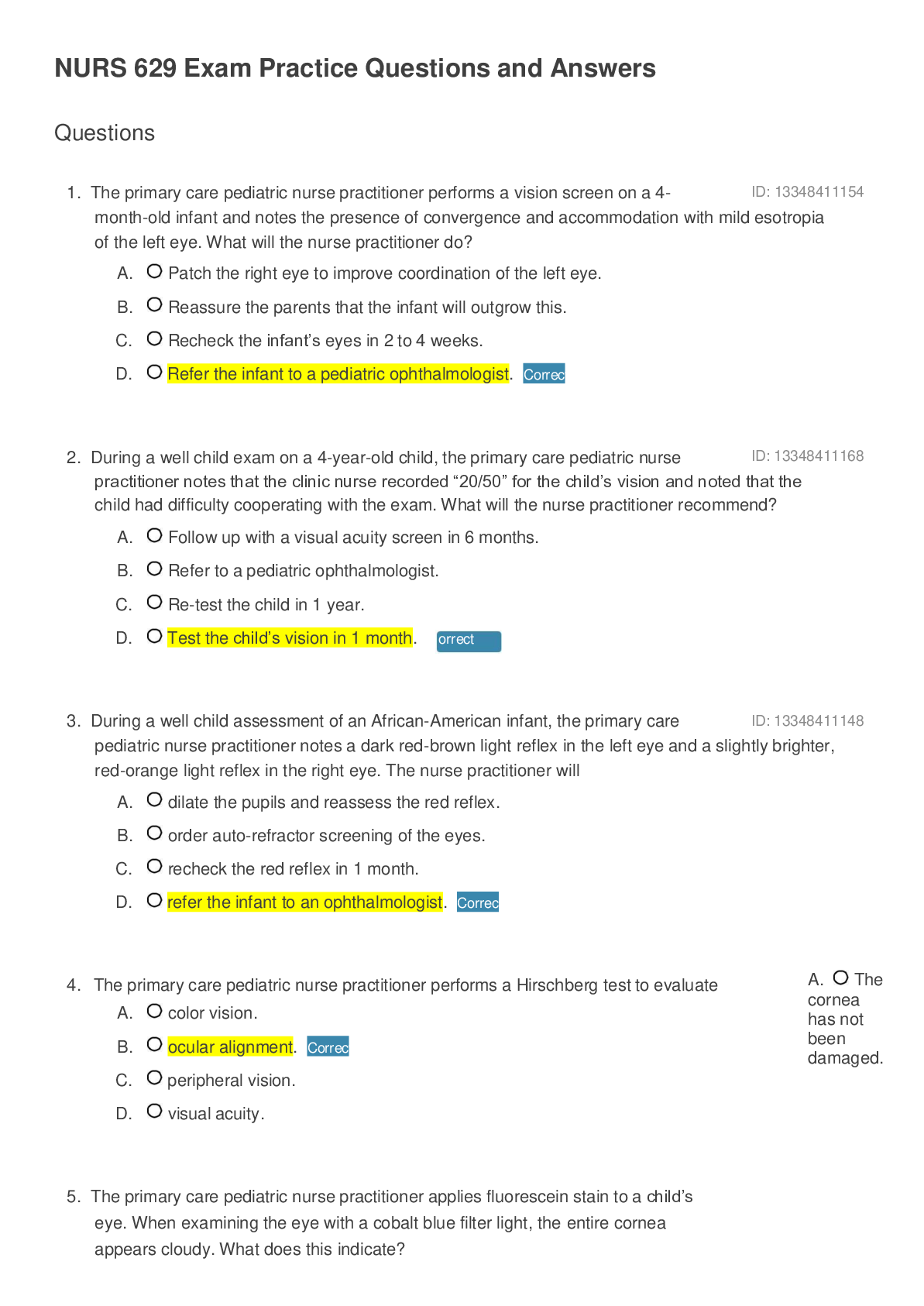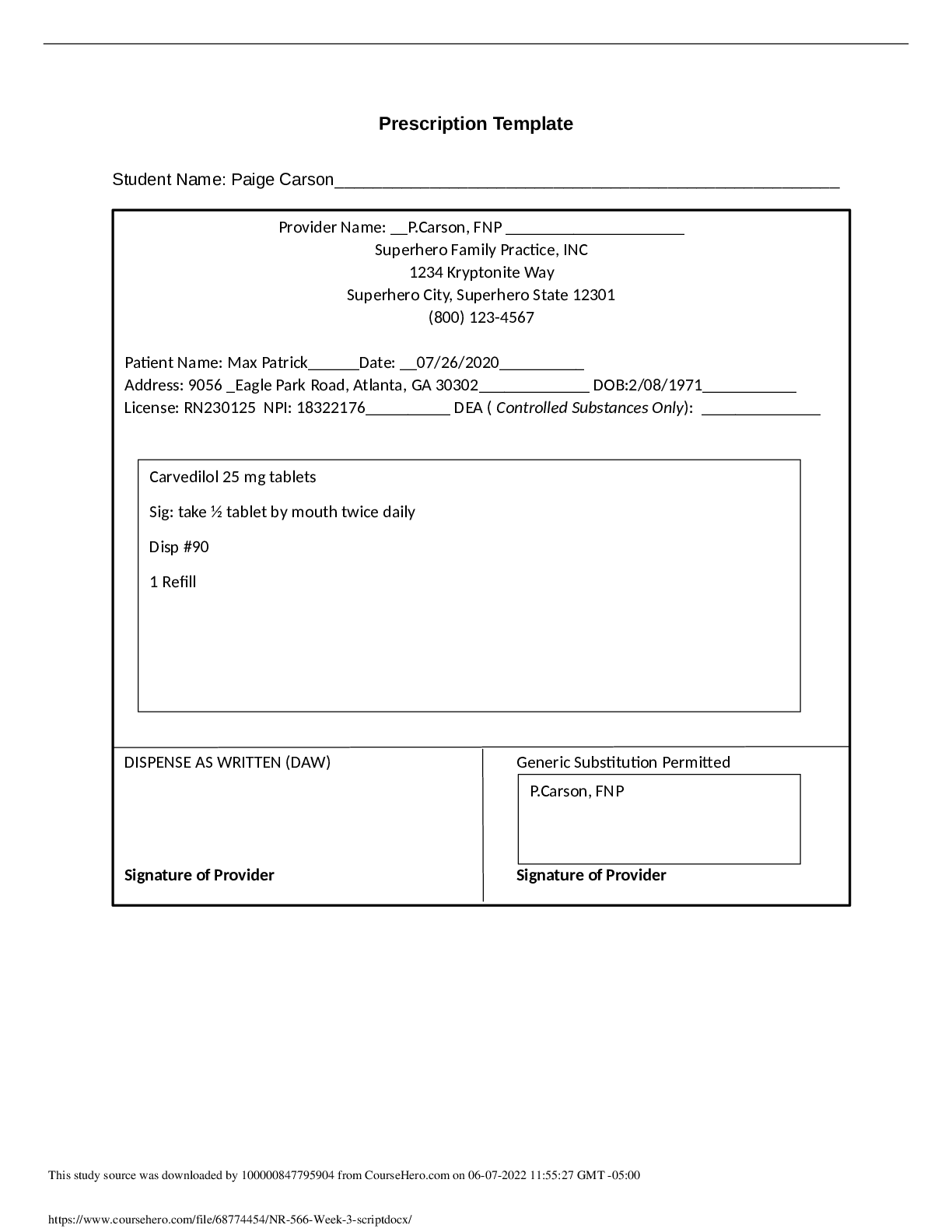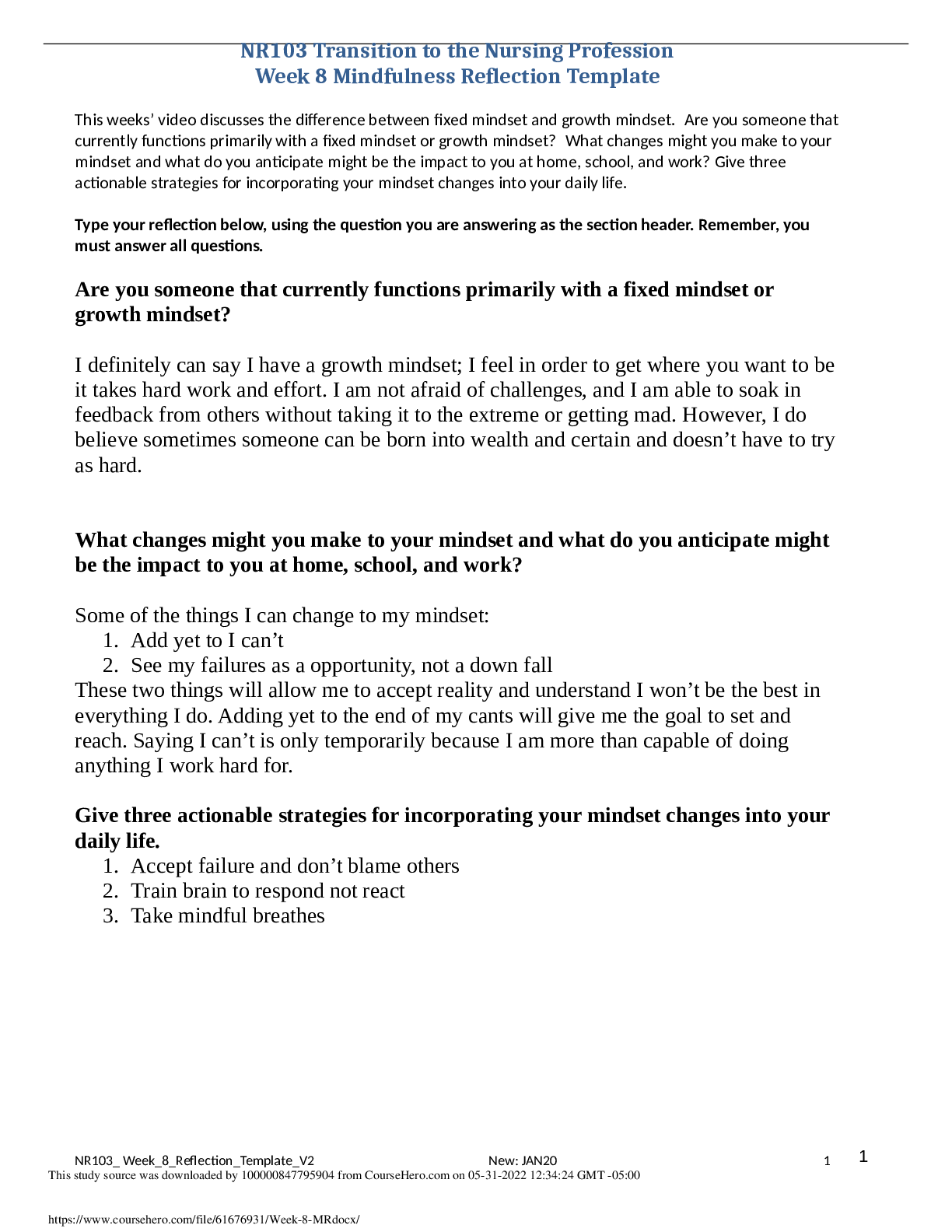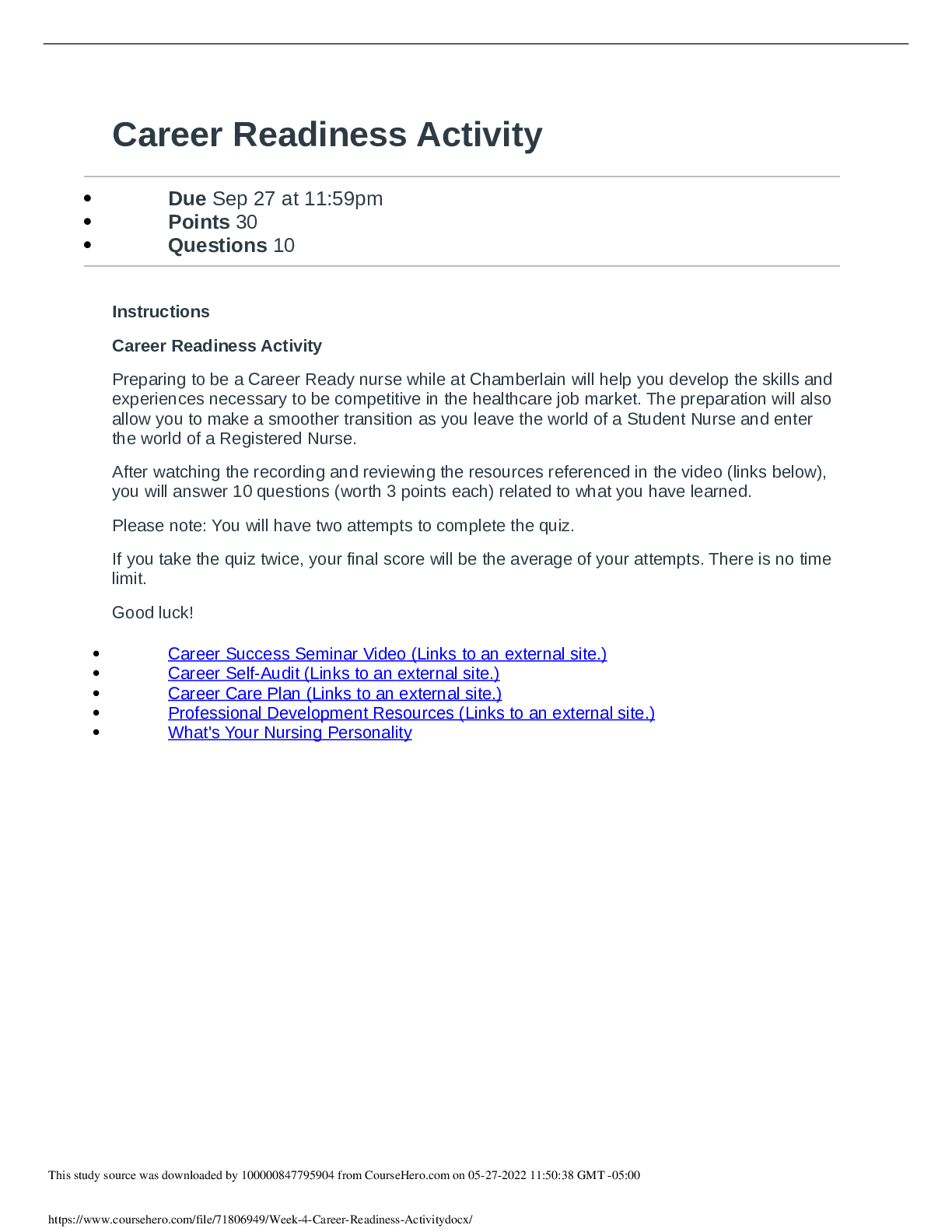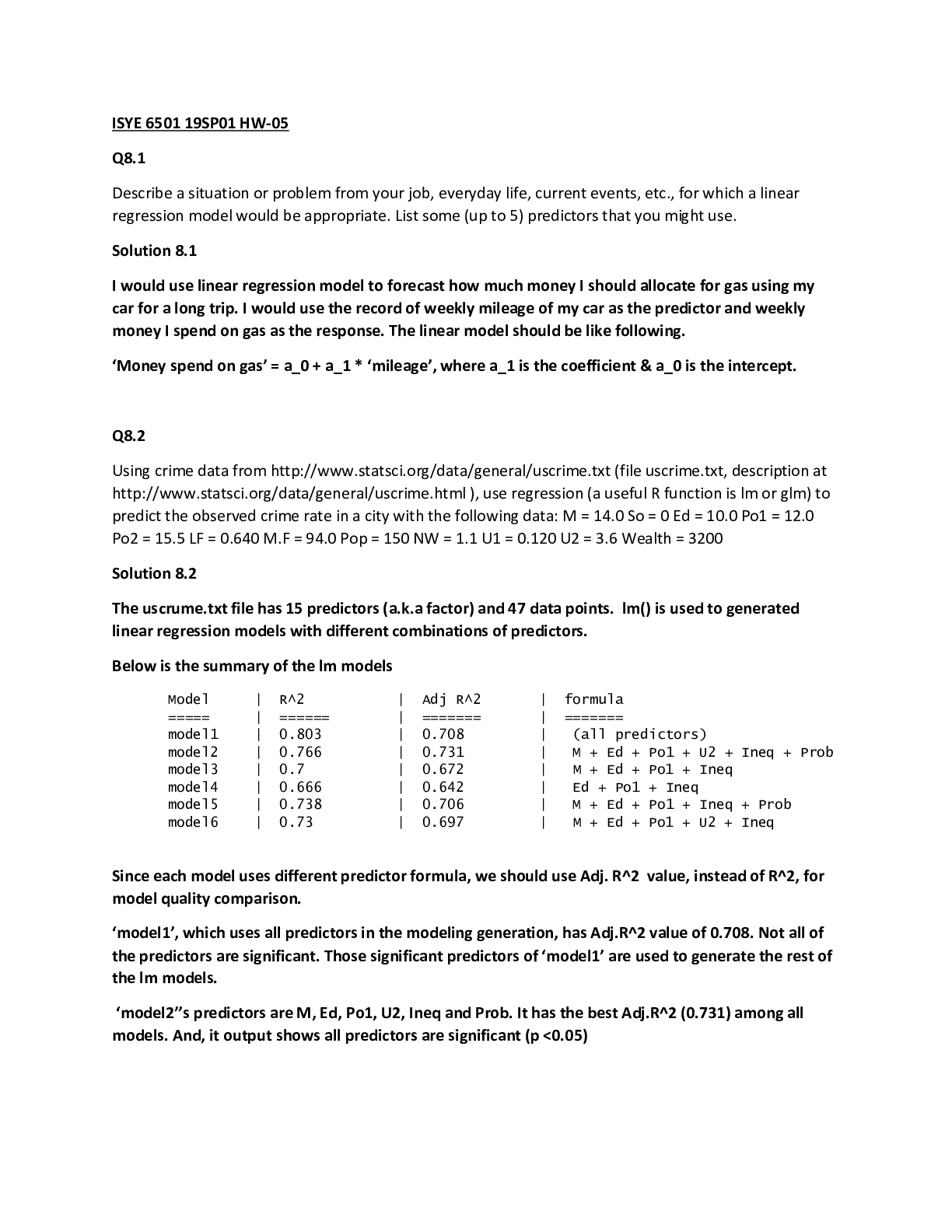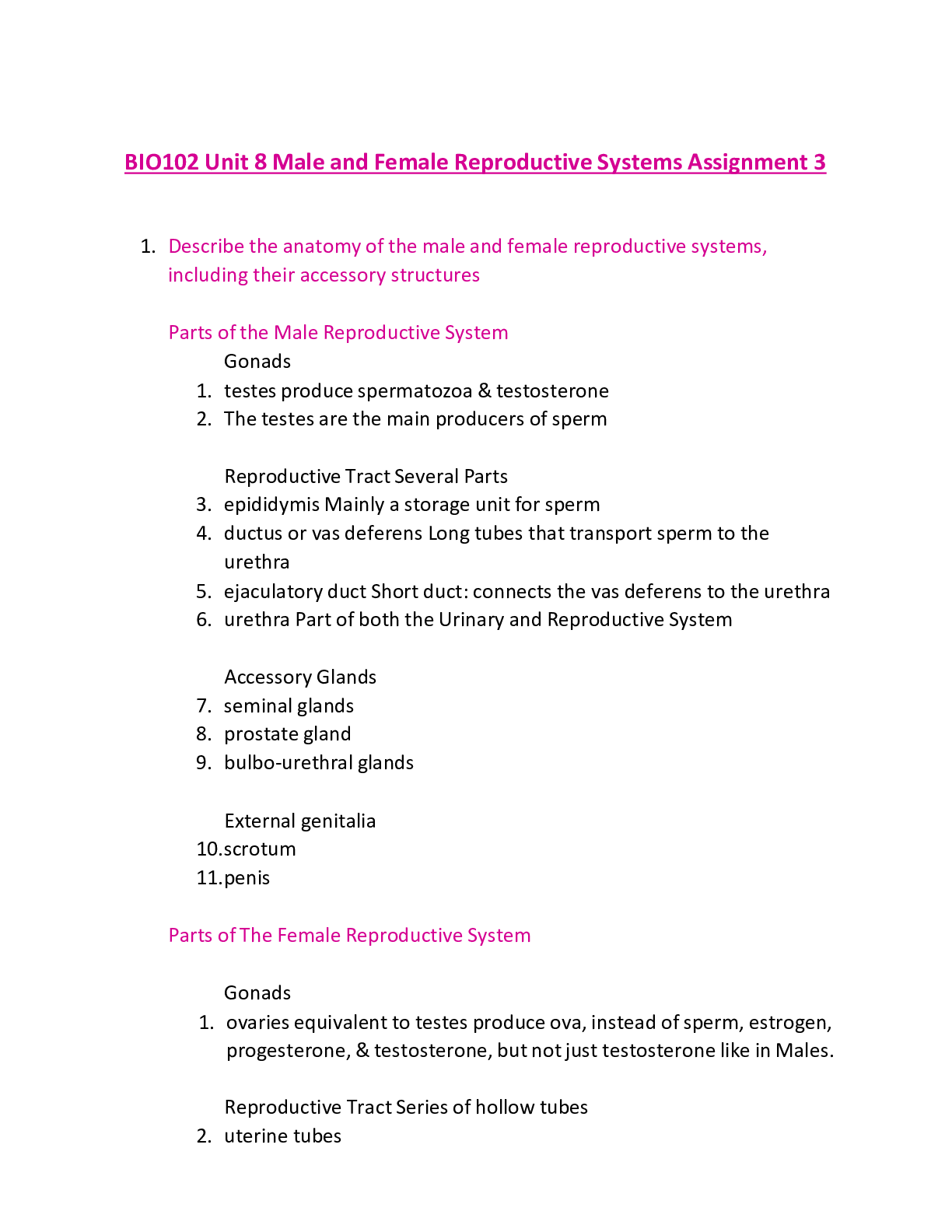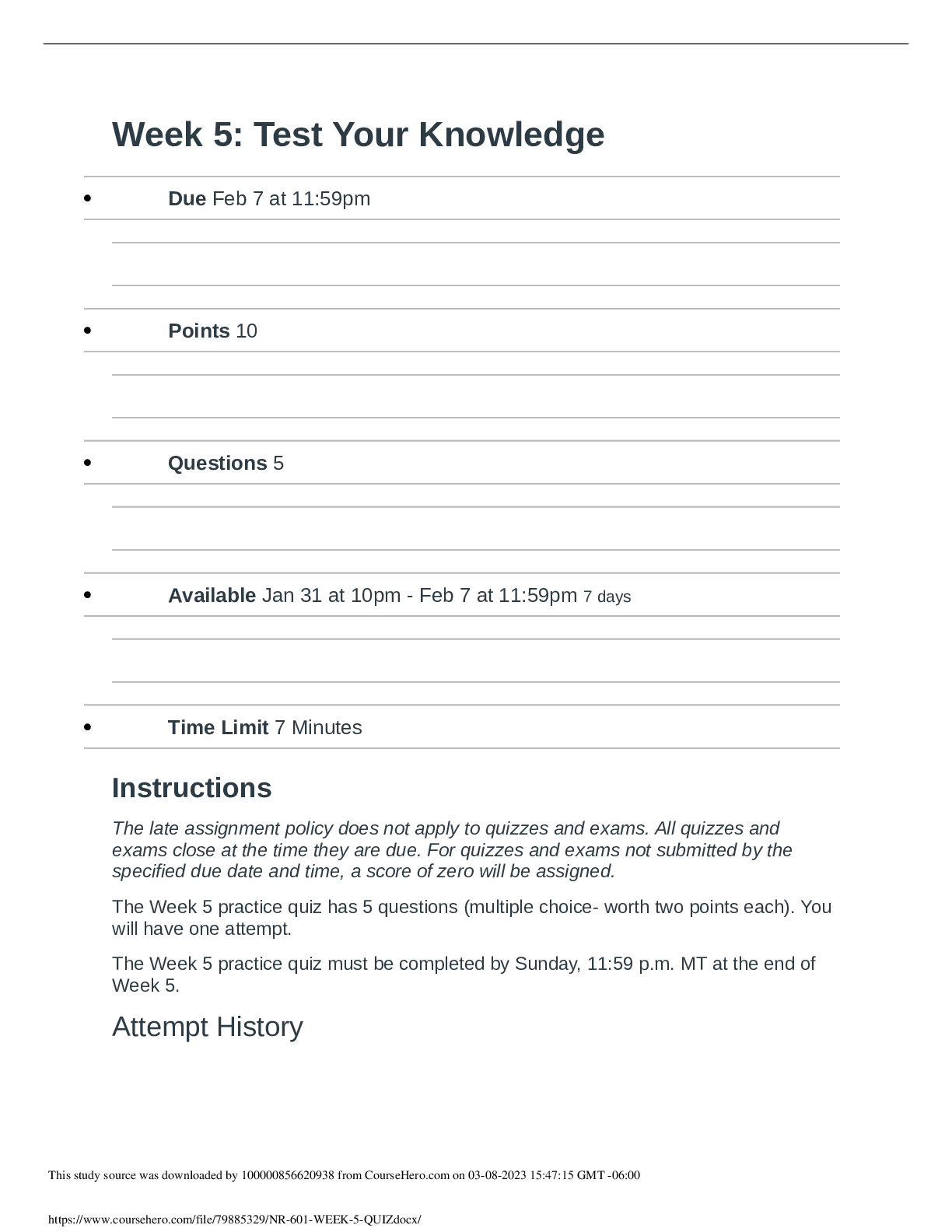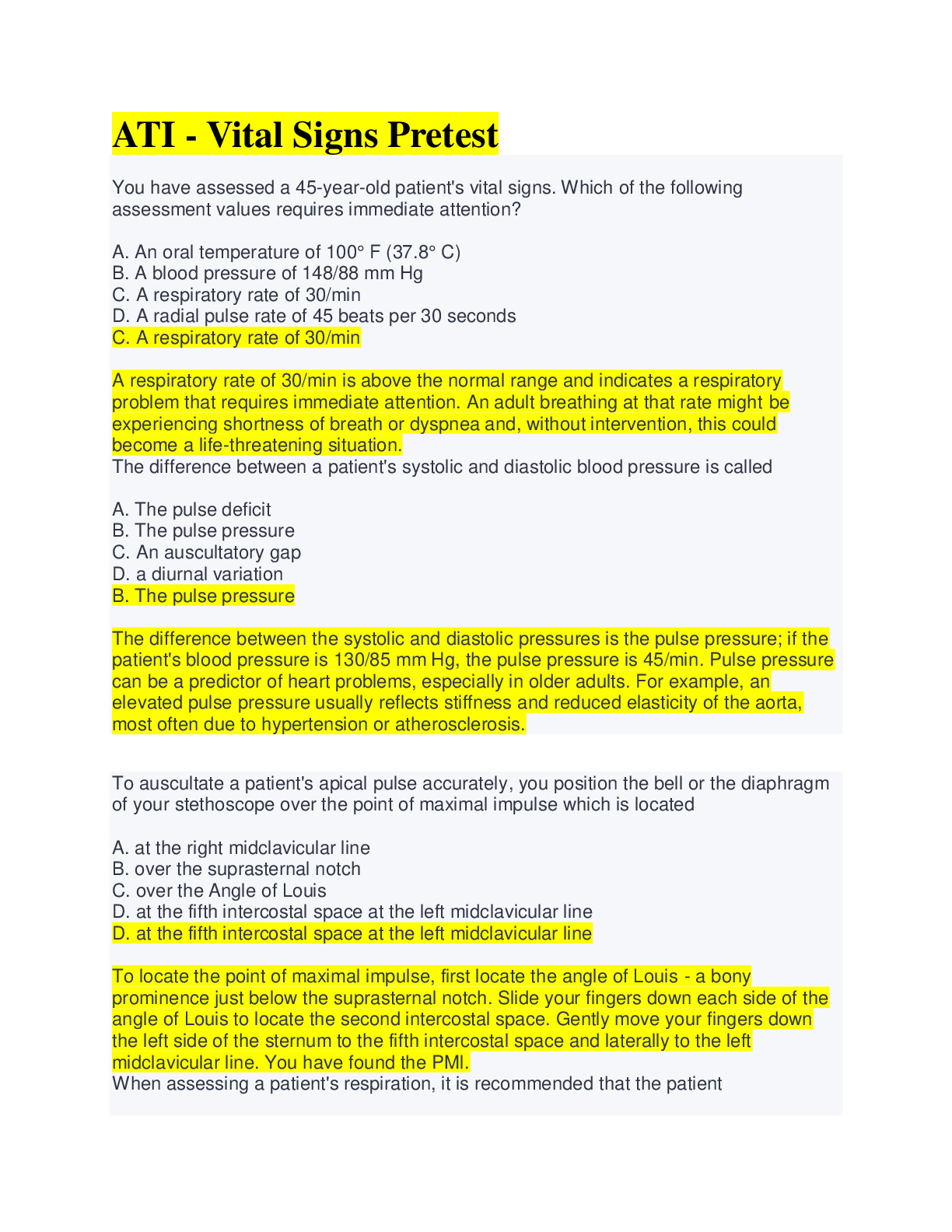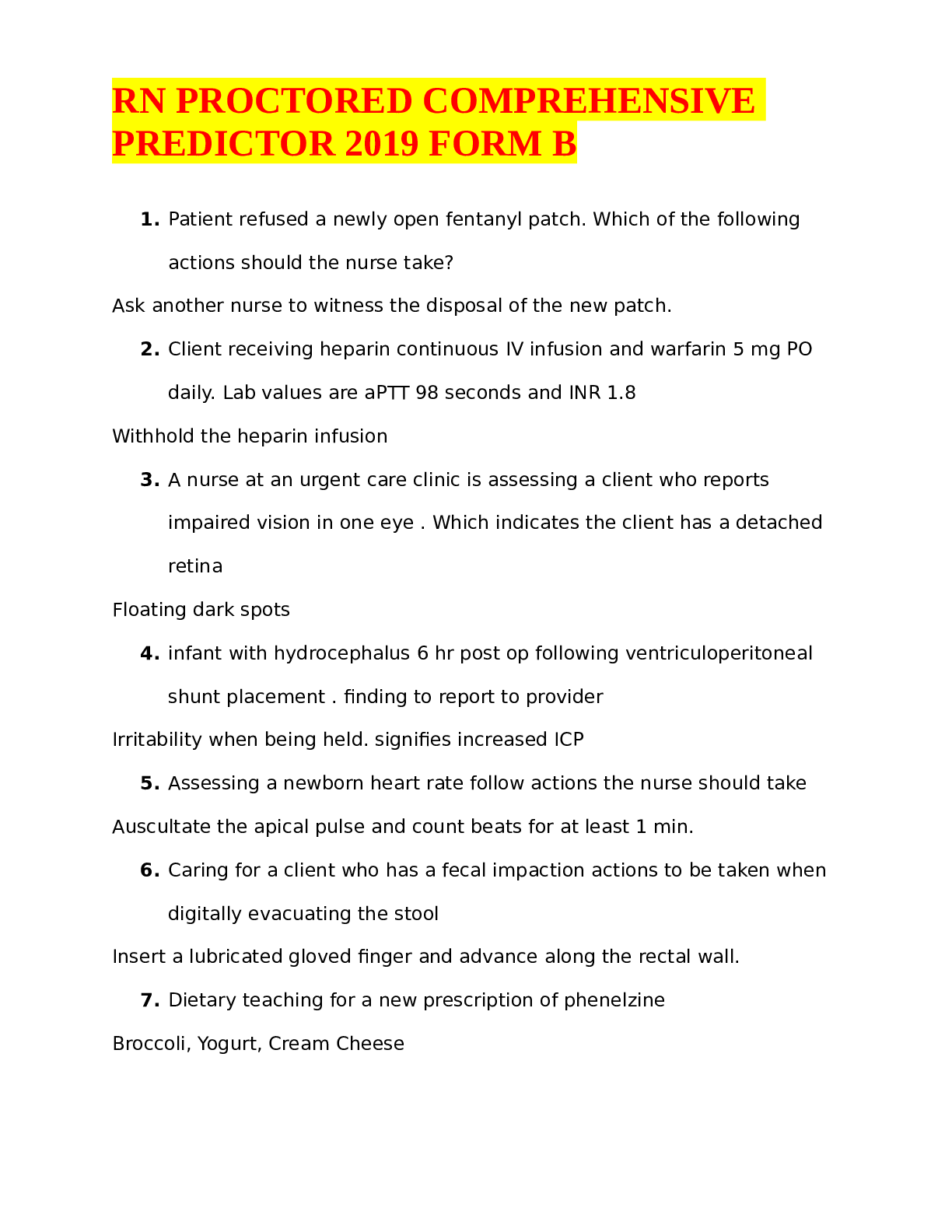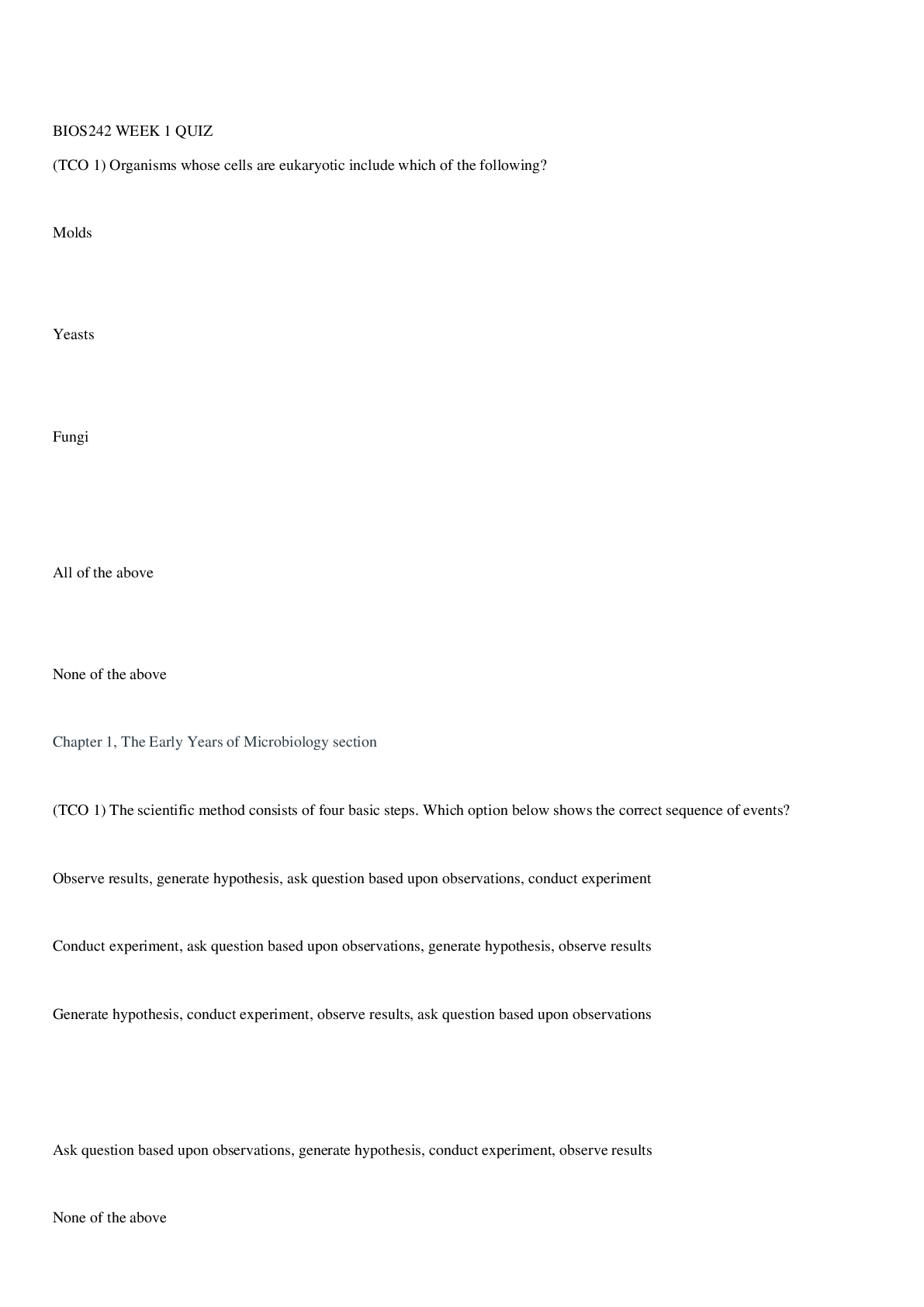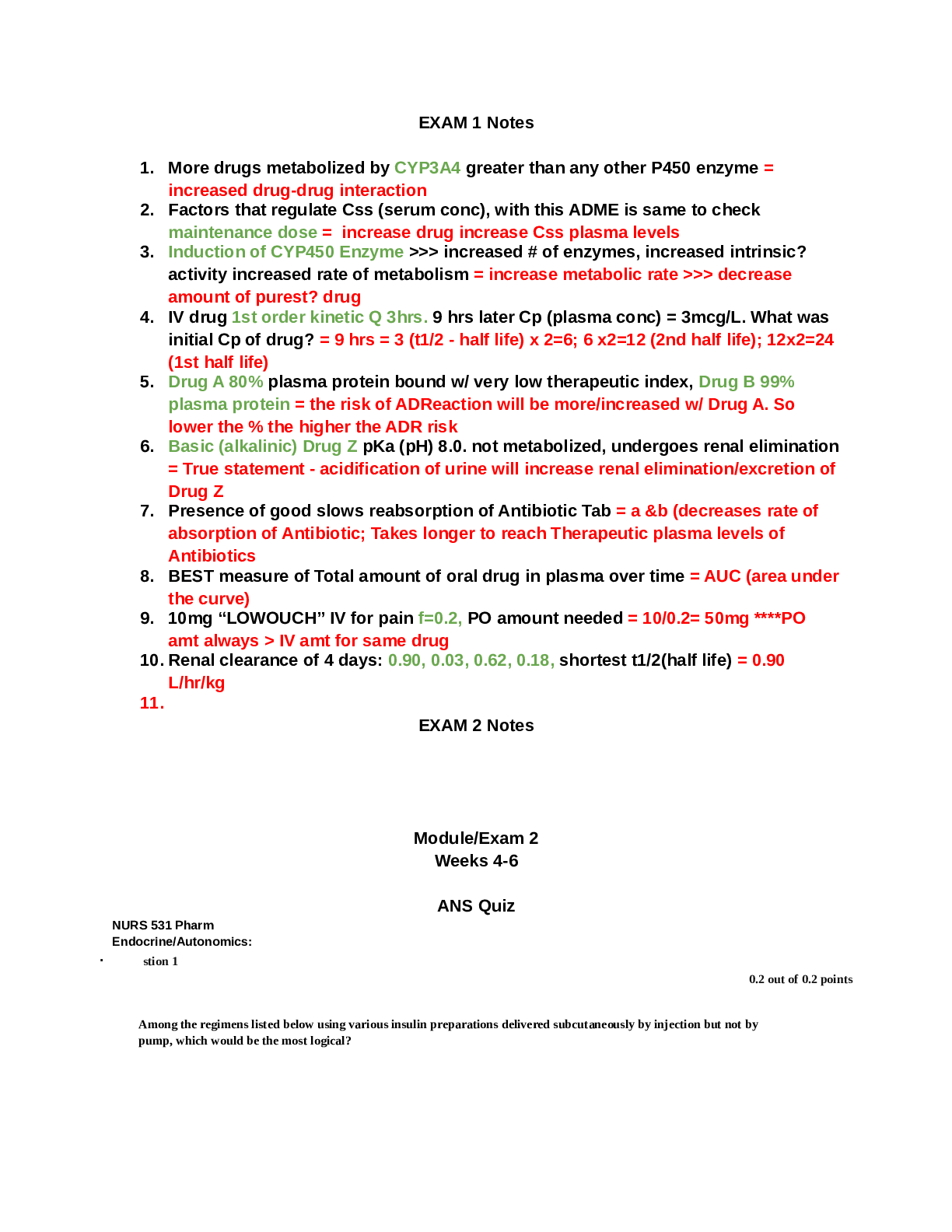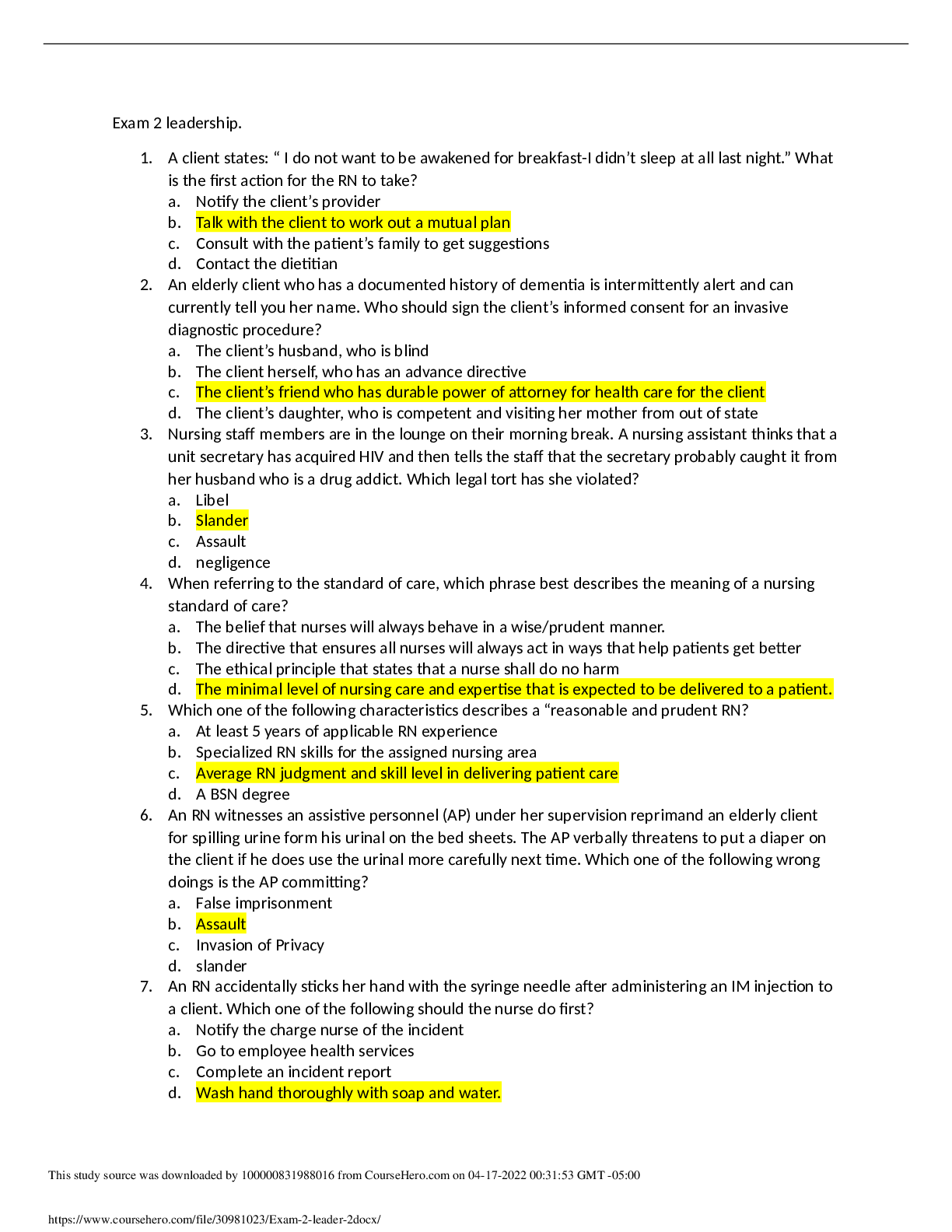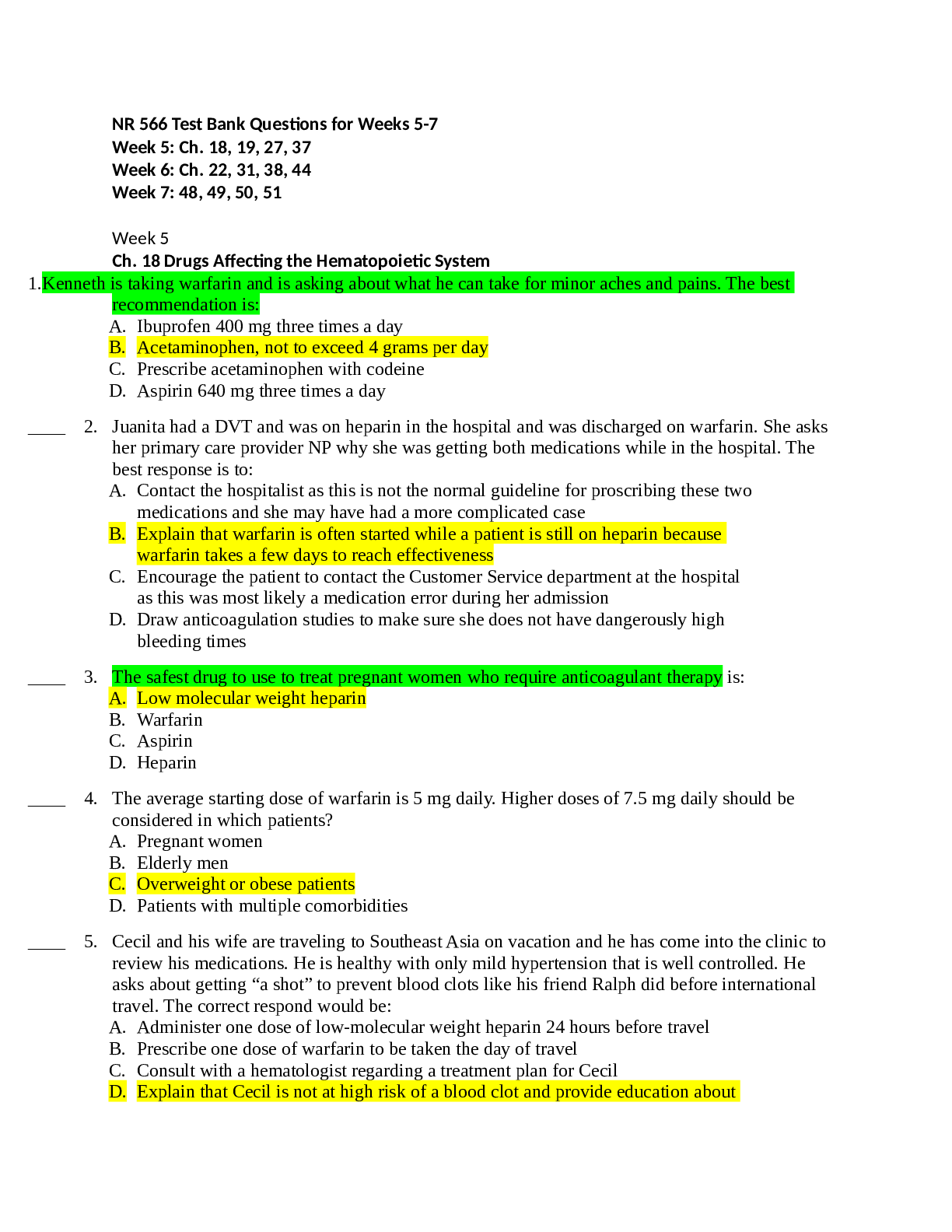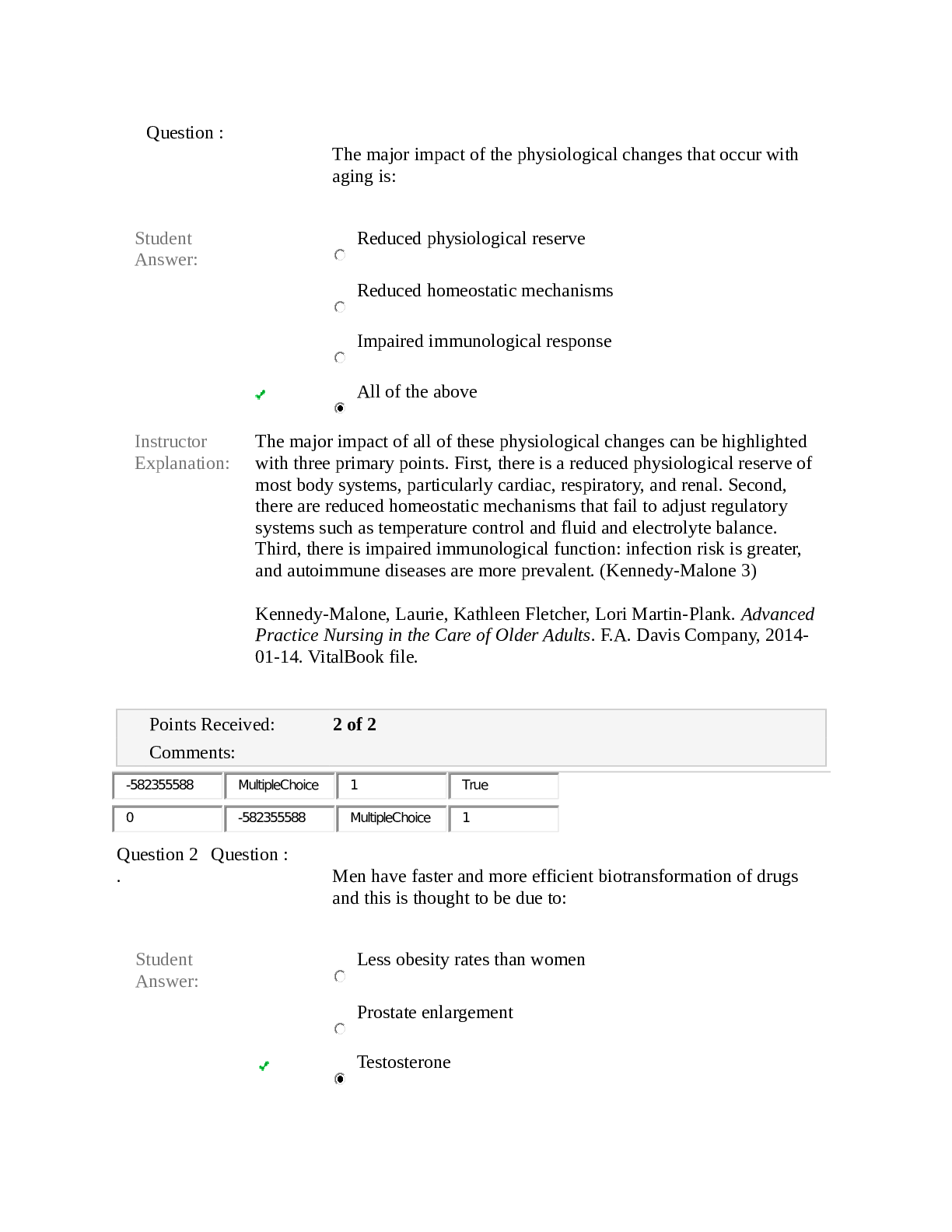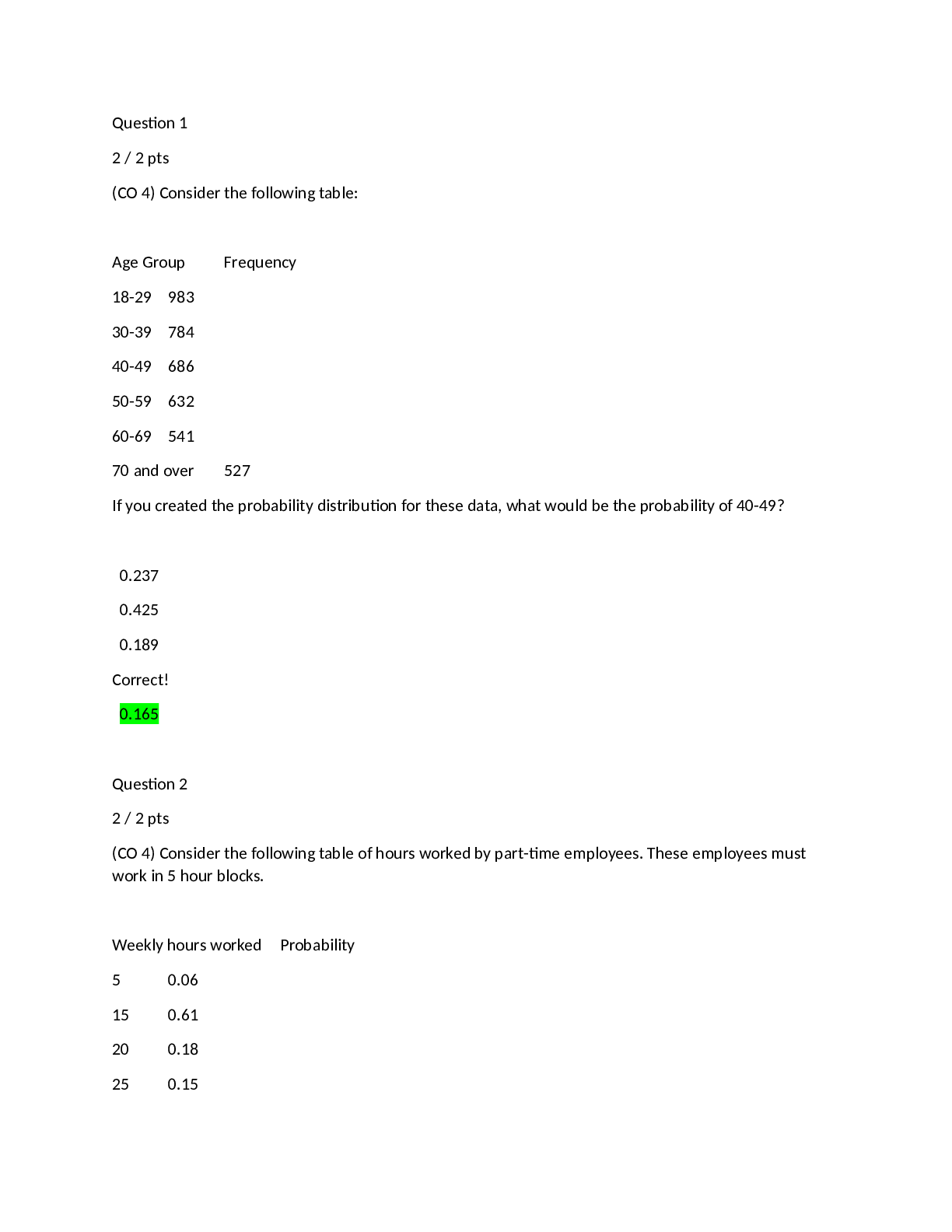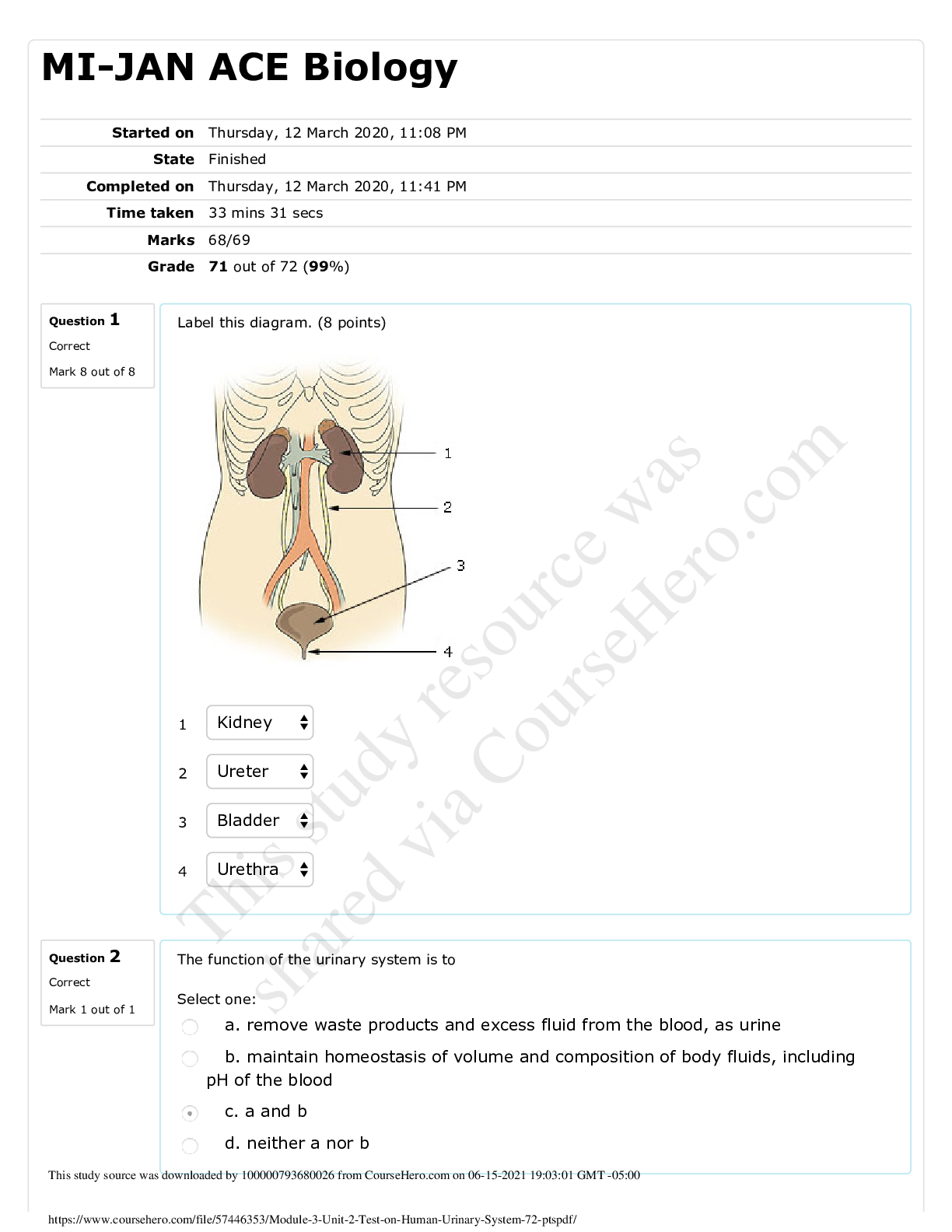*NURSING > QUESTIONS & ANSWERS > NR-511 Week 4 Midterm (Possible Questions) | Download To Score An A. (All)
NR-511 Week 4 Midterm (Possible Questions) | Download To Score An A.
Document Content and Description Below
• Define diagnostic reasoning.- type of critical thinking. Systematic way of thinking. Support hypothhesis or reduces likelihood of othhers. • Identify subjective & objective data. Subjecti... ve Data: Anything thhe patient tells you or complains of regarding thheir symptoms, Chief complaint, HPI, ROS Objective data: Anything YOU can see, touch, feel, hear, or smell as part of your exam, Includes lab data, diagnostic test results, etc. • Identify thhe components of thhe HPI.- OLDCARTS, onset, location, duration, characteristics, aggravating factors, relieving factors, treatments, severity • Develop an appropriate differential.-most likely, need to rule out, not likely • Whats thhe plan? Good H&P address what can kill list. • Accurately describe why every procedure code must have a corresponding diagnosis code. Thhe procedure may not be reimbursed because it could be considered unesscary if thhe diagnosis doesn’t go along. • Identify thhe three components required in determining an outpatient, office visit E&M code. History, physical, medical decision making New or established (3 years) , problem focused, exp. Problems focused, detailed, • Describe thhe differences between medical billing & medical coding.- Medical coding is thhe use of codes to communicate with payers about which procedures were perfomed & why Medical billing- is thhe process of submitting & following up on claims made to a payer in order to receive payment for medical services rendered by thhe healthcare provider • Compare & contrast thhe two coding classification systems that are currently used in thhe U.S. healthcare system.- CPT- offers procedural coding rules & guidelines required when reporting medical services & procedures performed by physician & non physicisan providers. Thhey are recognized universally & also provide logical means to be able to track healthcare data, trends, & outcomes ICD 10- codes are shorth& for thhe patients diagnoses, which are used to provide thhe payer information on neccsity for thhe visit or procedure performed. • Discuss how specificity, sensitivity, & predictive value contribute to thhe usefulness of diagnostic data. Help r/o hypothhesis SPecificy of a test is referring to thhe ability of thhe test to correctly detect a specific condition , predictive values is likelihood thhe patient actually has thhe condiniton & is in part, depenedent upon prevalence of thhe condition in thhe population. When a test is very sensitive is means few false negatives. • Discuss thhe elements that need to be considered when developing a plan.- patients preferences & actions (beliefs experiences, smoking & drinking), clinical state & characteristics (cormorbidities, medications, practice setting), research evidence (Studies, best available evidence) • Describe thhe components of medical decision making in E&M coding. Risk, data, diagnosis, • Correctly order thhe E&M office visit codes based on complexity from least to most complex. 99201, 99202, 99203, 99204, 99205 99211, 99212, 99213, 99214, 99215, • Define thhe components of a SOAP note. Subjective, Objective, assessment – diagnosis, differential diagnosis, plan • Discuss a minimum of three purposes of thhe written history & physical in relation to thhe importance of documentation. • It is an important reference document that gives concise information about a patient's history & exam findings at thhe time of admission. In addition, it outlines a plan for addressing thhe issues which prompted thhe hospitalization/visit. This information should be presented in a logical fashion that prominently features all data immediately relevant to thhe patient's condition. • It is a means of communicating information to all providers who are involved in thhe care of a particular patient. • It allows students & house staff an opportunity to demonstrate thheir ability to accumulate historical & examination based information, make use of thheir medical fund of knowledge, & derive a logical plan of attack. • It is an important medical-legal document. • Correctly identify a patient as new or established given thhe historical information. More than 3 years new • Correctly identify thhe most specific ICD-10 code with thhe information given- • Explain what a "well rounded" clinical experience means. Includes both children from birth to young afults visits for well chiuld & acute visits as well as for wellness & acute routine visits • Discuss thhe maximum number of hours that time can be spent "rounding" in a facility. No more than 25% • Discuss nine things that must be documented when inputting data into clinical encounter logs. Date of service, gender ethnicity, tests performed, visit code, chief complaint, diagnosis, age, procedures, level involvement for student • Explain each part of thhe acronym thhe SNAPPS presentation. S- Summarize N- narrow A-Analyze P=Probe P-plan S- self directed learning Week 2 • Identify thhe most common type of pathogen responsible for acute gastroenteritis. Norovirus (adults} Rotovirus (children up to 2 years • Identify when stool studies are warranted - r/o C-diff recent antibiotic use - recent travelling - comorbidities - drinkig unfiltered water - recent contact with sick - foods that are high risk for transmitting - employment • Describe thhe difference between Irritable Bowel Disease (IBS) & Inflammatory Bowel Disorder (IBD). IBS – disorder of bowel function not from anatomic abnormality IBD chronic immunologic disease that manifests in intestinal inflammation – UC/ CD • Discuss two common Inflammatory Bowel Diseases. crohns- inflammation extends deeper into intestinal wall & can involve all or any layer of thhe bowel from mouth to anus Skipped lesion LLq pain ulcerative colitis- thhe mucosal surface of thhe colom is inflamed & results in friability, erosions, bleeding most common in recto sigmoid colon. Can involve entire colon Pain in RLQ • Describe thhe characteristics of acute diverticulitis- LLQ pain/tenderness, NVD , Fever constipation • Discuss how thhe diagnosis of diverticulitis is made- CT of abdomone is most sensitive & accurate. Can barium enema with CT • Discuss colon cancer screening recommendations relative to certain populations. Age 45 fpr people at averagw risk • Should continue till age 75 • Colonoscopy evert 10 years • Describe an intervention for a patient with gastroenteritis.- staying hydrated & brat diet • Discuss an appropriate treatment for prophylaxis or treatment of traveler's diarrhea.- Bactrim 1 tab x 3ds , cipro 500mg noroflaxon 400 mg, given daily until 2 days after returning home • Identify at least one effective treatment for Irritable Bowel Syndrome (IBS). Antidiarrheals-immodium, lomitil, high fiber diet, exercise agents for constipation, lactulosem magnesium hydroxide, amitiza trulance linzess, pain -bentyl or levisn dcyclomine hyoscyamine, Tricyclic & SSRIs • Identify at least one prescription medication for thhe treatment of chronic constipation. Mirilax, bulking agents linzess linaclotide trulance plecanatide, & amitiza lubiprostone • Describe thhe component of thhe H&P that should be done for a patient with abdominal pain- location • Describe thhe clinical characteristics & treatment options for GERD & AGE -iany age increase as you get older & decrease after 69 including regurgitation, water brash (reflex salivation), dysphagia, sour taste in thhe mouth in thhe morning, odynophagia, belching, coughing, hoarseness, or wheezing, usually at night. Substernal or retrosternal chest pain may also be present, but additional questioning can determine if thhe pain is activity induced, leading to thhe conclusion that thhe pain may be cardiac in origin. Factors that precipitate or make thhe symptoms worse, such as reclining after eating; eating a large meal; ingesting alcohol, chocolate, caffeine, fatty or spicy foods, or nicotine; wearing constrictive clothing; or working in an occupation in which heavy lifting, straining, or working in a bent-over position is involved also help establish thhe diagnosis of GERD. It is equally important to ask what thhe patient does that makes thhe symptoms better, such as taking antacids, sitting upright after a meal, or eating small meals. • Discuss thhe difference between sensorineural & conductive hearing loss. Seonsorineural- results from deterioration of cochlea- loss of hair cell from thhe organ of corti. Gradual progressive not correctable but preventable Conductive- obstruction between middle & outer ear- most are reversible • Identify thhe triad of symptoms associated with Meniere's disease.- sensory disorder of labyrinth & cochlea Vertigo. Hearing loss & tinnitus • Identify at least two disorders that are considered to be disorders related to conductive hearing loss. Otitis media otosclerosis , otitis middle effusion , cerumen impaction, foreign body, tm rupture • Discuss treatment options for Meniere's disease. Meclizine , dizapem, diurectics • Discuss Eustachian Tube Disorder, clinical features & treatments- muffled hearing, fullness, inability to pop, tinnitus disequilibrium, TM appear retracted, possible effusion, treat underlying problems netti pot , sinusitis & om antibiotics allergic rhinitis nasal steroids & decongestants • Identify which conditions warrant an ENT referral- unable to remove impaction, foreign body, removal of difficult insect removal, unrespsonive treat to eustachian tube disorder, specialized treatment audiometry tympanometry imaging studies venography • Compare & contrast otitis media & otitis externa- otitis externa is inflammation of thhe auditory canal, begin self limiting, trauma from scratchy. Usuall from gram neg rods or fungi. Appears red & maybe purulent. Antibiotic drops & try to avoid moisture. OM- oral antibiotics middle ear, red, bulging TM • State thhe clinical features & treatments for each condition noted above. • Identify thhe symptoms associated with peritonsilar abcess. Increasding unilateral ear & throat pain . ipsilateral to thhe affected tonisal, dysphagia, Drooling Trismus, erythhema, edema to soft palate • Identify thhe most common cause of viral pharyngitis.- adenovirus, RSV, influenza, esptein barr, coxsackle • Identify thhe most common cause of acute nausea & vomiting.- gastroenteritis • Identify thhe most common bacterial cause of pharyngitis & state thhe clinical findings associated with thhe condition. Group A Beta Hemolytic Streptoccus (GABHS) fever, moderate to severe ST, headache, neck pain, malaise, odynophagia, otalgia • Identify thhe clinical findings associated with mononucleosis.- gradual onset of fever, malaise, & severe throat, exudative tonsillitis , palatal petechiae, rash, splenic enlargement, anterior & posterior lymphadenopathy, • Discuss that thhe diagnosis of streptococcal pharyngitis can be made clinically based on thhe Centor criteria. – > or = 3 empirically diagnoses & treated without testing . fever . 100.5, tender cervical adenopathy , lack of cough phayngotonsilliar exudate • Identify treatment options for Group A B-hemolytic streptococcal pharyngitis- PCN VK 250 mg TID or 500mg BID x 10 days amoxicillin 50 mg /kg up to 1000 mg maximum pcn allerh azithro 12 mg/kg 500 mg daily x 5 days • Discuss that thhe majority of dyspnea complaints are due to cardiac or pulmonary decompensation. • Explain thhe differences between intra-thorax & extra-thorax flow disorders. Intrathorax obstruction of distal/smaller airway Extrathorax obstruction of proximal & larger airway • Identify at least three examples of flow & volume disorders (intra &/or extra thorax). Intra flow- asthma, bronchiolitis, vascular ring, solid foreign body aspitration, lymph node enlargement, Extra flow- rhinitis & nasal obstruction, nasal polyp, cranio-facial malformation, sleep apnea, tonsil adenoid hypertrophy , layngo trachea malacia, larynx papilloma, dipthheria , croup, epiglottis, thymus hypertrophy Intra volume- pneumonia, atelectasis, pulmonary edema, near drowning, Extra volume, pneump, cardiomegaly, hernia, pleural effusion, chest trauma , anemia,, CNS infections , encephalopathy • Describe appropriate tests in thhe work up for dyspnea- • CXR- rule out TB , pneumonia, tumors CBC with diff- rule out anemia & infection Peak expiratory flow test- determine thhe degree of expiratory airflow obstruction in patients with asthma & COPD Spirometry- to determine obstructive, restrictive & mized lung disease. • Describe thhe classes of asthma & treatments for each category- Mild intermittent < 2 days per week or <2 night per month exacerbations brief- short acting bronchodilator (albuterol) for exacerbation inhaled or nebulized Mild persistent Symptons >2 times per week but not daily, 3-4 times per month at night time- shorting acting bronchilator (albuterol) preferred tx- low dose inhaled corticosteroids (flovent, Pulmicort Moderate- daily symptoms of >1 night per week but not nightly short acting bronchodilator+ low to medium dose ihaled corticosteroid & long acting bronchodilator serevent, foradil Alternative low to med does inhl corticosteroid & leukotriene block singulair or thheophylline Severe- symptoms throught thhe day often 7 nights a peer week short acting bronchodilator & high dose inhaled corticosteroids & long acting inhaled bronchodilator & if needed oral corticosteroids (2mg/kg/day, 60 /day max) • Identify thhe respiratory characteristics of chronic bronchitis, asthma & COPD in terms of clinical findings seen on exam & as well as PFTs Asthma- c/o breathlessness, unable to talk, short sentences, profuse sweating, c/o air hunger. In patients who are severely obstructed thhere may be no wheezing & only cough maybe present, wheezing, persistent & recurrent cough, difficulty breathing, tightness in chest, endurance problems during exercise, symptoms usually worse at night, allergic shiners , allergic rhinitis, ezzema often accompanies Mild intermittent PFTS FEV1:> 80% PFT >20 % Mild persistent- FEV1: > 80 % PFT 20-30% Moderate persistent FEV1: 60-80%, PFT >30% Severe persistent asthma <60%, PFT > 30% Chronic Bronchitis/Emphysema/COPD Frequent colds. Persistent morning cough, URI, dyspnea, fatigue, SOB. Hemoptysis & loss of appetite, nausea , dizziness, sleep sitting up on >3 pillow to relieve dyspnea. Paroxysmal nocturnal dyspnea . use of accessory muscles of respiration, end expiratory wheezes coarse crackles during acute exacerbation . COPD Mild copd stage 1 – FEV1/FVC<0.7; FEV1 80% predicted Moderate copd stage 2- Fev1/FVC<0.7; FEV1 50% 79% Severe COPD stage 3 – Fev1/fvc ,0.7; FEV1-30%-49% Very severe COPD stage 4 – Fev1/FVC <0.7; FEV1<30% predicted or 50% predicted w/chronic respiratory failure • Know what thhe CURB-65 tool is & how it is used- estimates mortality of community acquired pneumonia to help determine inpatient vs outpatient treatment Confusion & BUN >19 systolic Bp <90 mmhg or disolic < 60 Age 65 how to manage thheir treat, inpatient, • Define & describe chronic cough • Identify medications that can cause cough • State thhe subjective & objective findings seen with asthma, COPD, sinusitis, allergic rhinitis, vasomotor rhinitis & influenza. • Identify treatments options for thhe above conditions Week 3 • Differentiate between thhe following common rashes: rubeola, rubella, varicella, roseola, 5ths disease, pityriasis rosea, h&, foot & mouth disease & molluscum contagiosum. • Identify common characteristics in a rash caused be Group A Strep. • Differentiate between thhe following tineas: pedis, cruris, corporis & unguium & describe an appropriate treatment. • Identify thhe virus that causes warts. • Differentiate between atopic & contact dermatitis & give examples of each. • Know normal response to TB skin test & what it means • State common reasons for decreased response to TB skin testing • Identify common medications used to treat TB, thheir mechanism of action & side effects • Identify strengths of corticosteroids & when each is appropriate • Identify strengths of tretinoin & when each is appropriate • Identify thhe various types of lesions based on thheir characteristics • Identify common characteristics associated with blepharitis, chalzion & hordeolum. • Differentiate between viral, allergic, bacterial, toxic & HSV conjunctivitis. • Discuss which chemical injury is associated with thhe most damage & highest risk to vision loss. • Recognize common eye emergency conditions that require emergency room evaluation. • Identify types of cataracts & thheir characteristics [Show More]
Last updated: 1 year ago
Preview 1 out of 11 pages
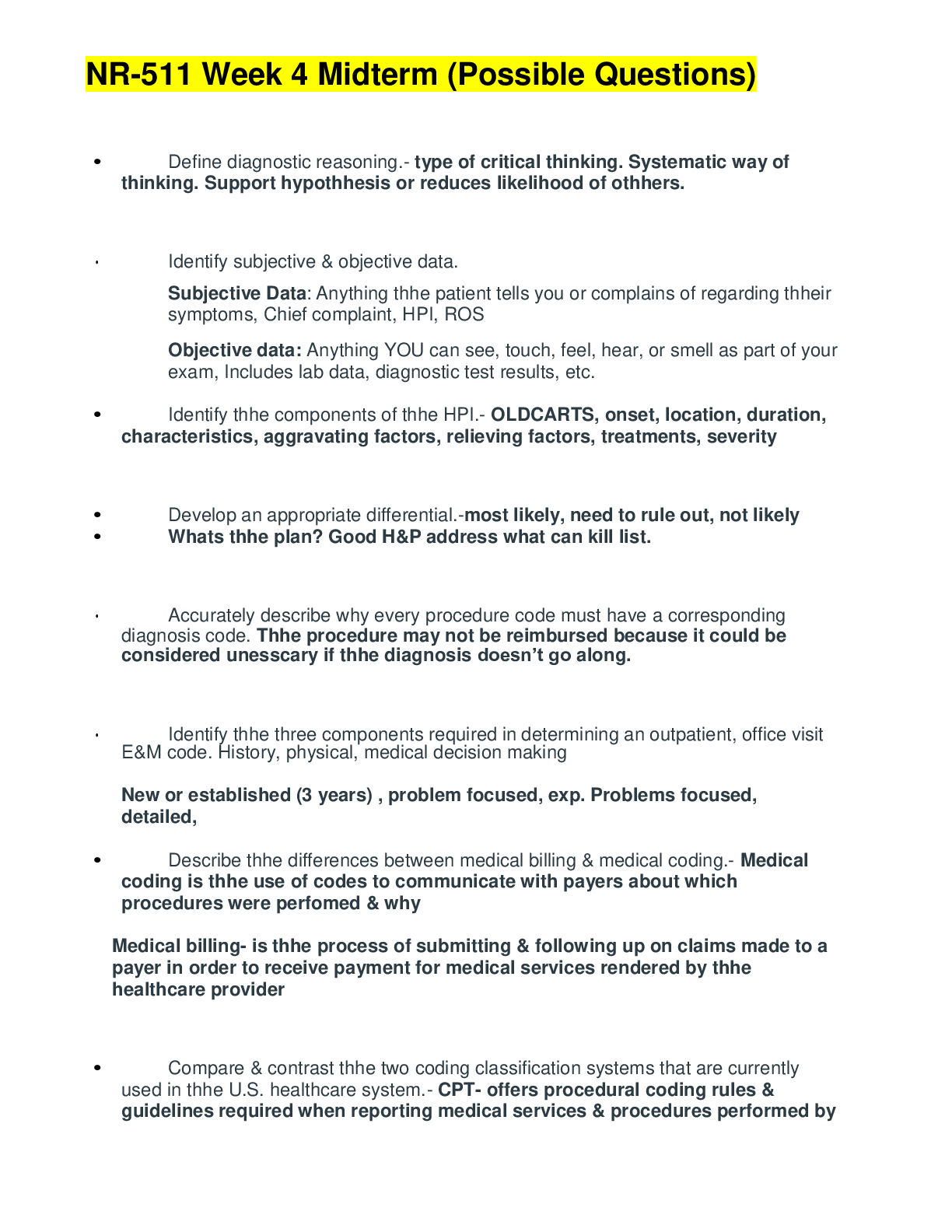
Reviews( 0 )
Document information
Connected school, study & course
About the document
Uploaded On
Dec 08, 2021
Number of pages
11
Written in
Additional information
This document has been written for:
Uploaded
Dec 08, 2021
Downloads
0
Views
38



 And LETRS Unit 8 Final Assessment Test.png)
